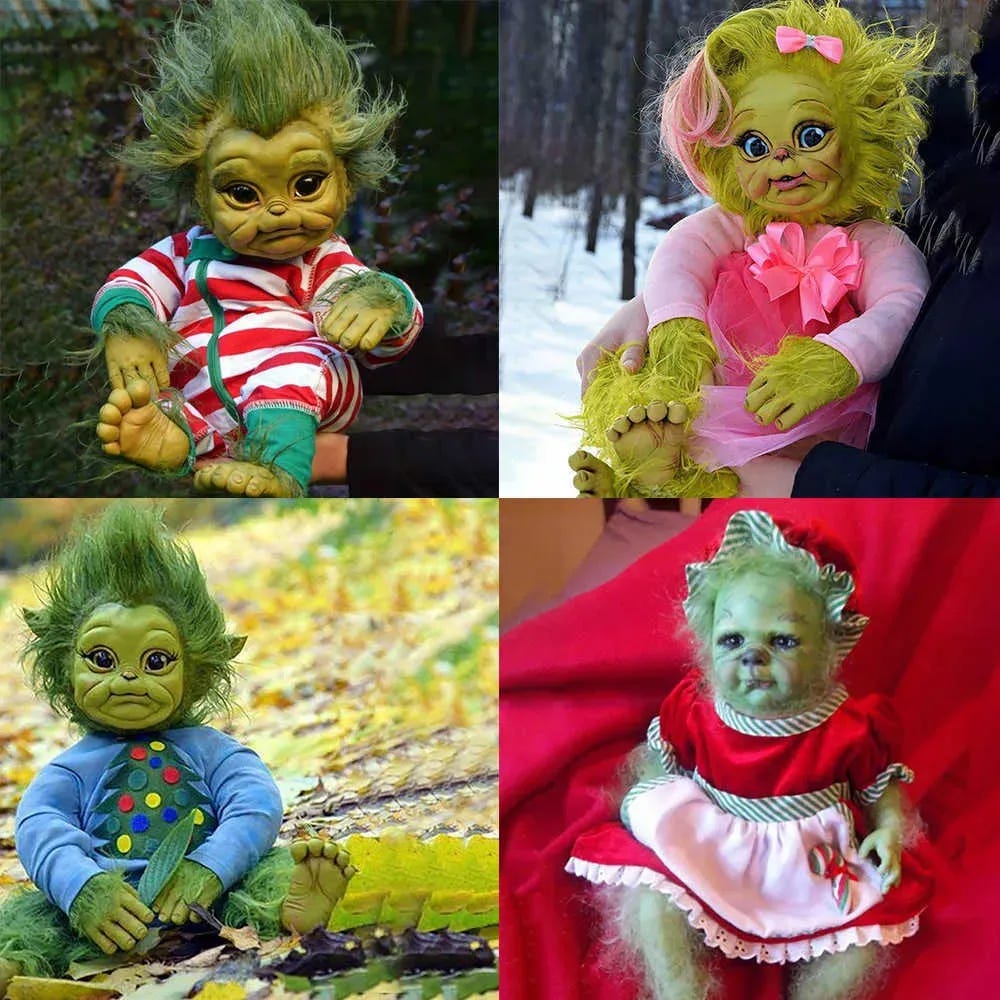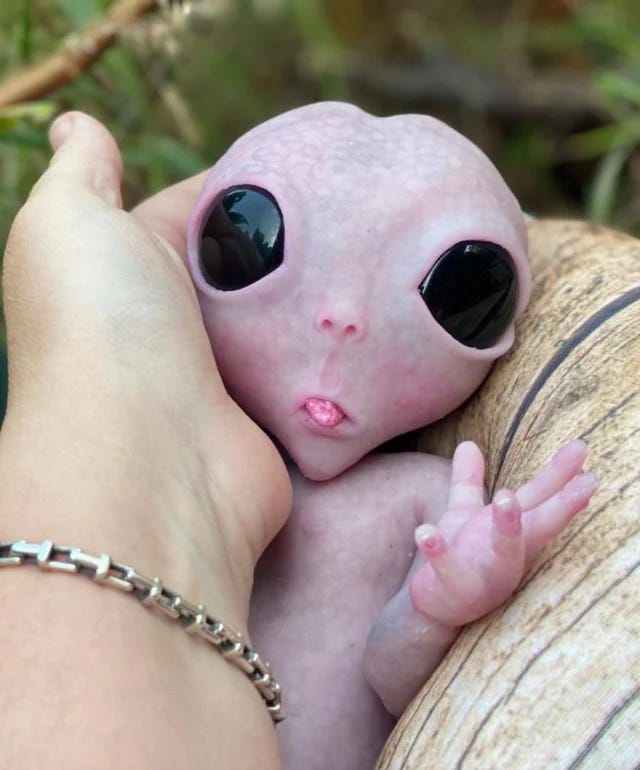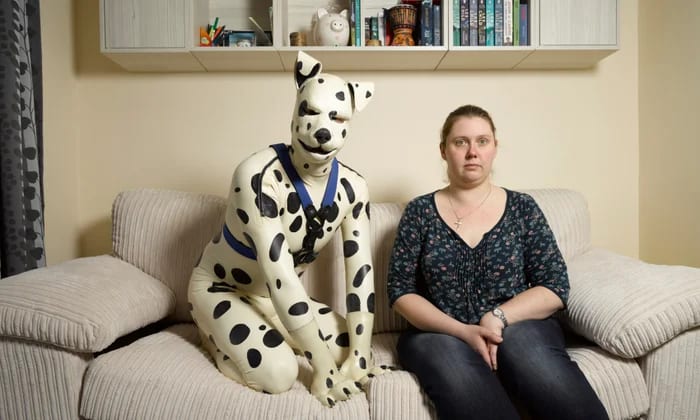By Popular Demand: My Reflections on Motherhood, pt. 2
Howdy. In the last post, linked here,
I’d been talking about my walk to the office the other day. A young woman pushing a stroller was up ahead of me, and I was trying to figure out how/when to overtake. This required thorough consideration of all relevant factors, which included the stroller, and specifically its occupant (assuming there was one).
What if she was one of those people who pushed their dog(s) around? Or what if it was one of those lifelike baby dolls? Or one of those dolls that appeal to what you’d have thought was a nonexistent niche in the market, the “lifelike” renditions of fictional characters, e.g. the Grinch:
(P.S., I’ve also learned they do these for aliens, too.)
With this thought, the inevitable question was what the hell was going on here, as far as these dolls. A digression, admittedly; Why worry about something so ridiculous and impossible? Well, that’s the thing. We’ve got to start taking this sort of thing seriously. Smart money, historically, would be that the customers only want these dolls for some sort of deviant/fetishistic behavior. But the world is changing; we’ve got to keep up. We’ve got to consider that there’s nothing Haram going on here, nor anything sexual at all, and the interest in these dolls is actually a manifestation of some obscure body dysmorphic disorder. As in, the owners “mothers” of these dolls “babies” in some way identify with their offspring; there’s some sort of genuine kinship bond there.
It’d only be a logical extension of the “Disney Adult” phenomenon: popular media has wormed its tendrils so deep into our collective consciousness that there’s no longer any demarcation between parasite and host (which one’s which!?). Our conceptions of even our most basic biological needs and functions can now only exist in relation/as a response to our media. (This explains, for example, the romanticization of previously abstract/uncommodifiable concepts such as “homemaking”. Even this has become a status symbol, an aesthetic™, something to be performed.)

To bring it back to the hyper-realistic doll question: Our “consensus reality” includes, of course, our coping mechanisms: i.e., the state-sanctioned/socially acceptable methods we’re given to address our mental/physical ailments. One such mechanism is elective plastic surgery. Hordes of young women (and quite a few men) have gone under the knife/needle because of internet-borne body dysmorphia/FOMO/etc. The opportunistic doctors must know that many/most of these people are mentally unwell, that the vast majority of procedures are detrimental/unhelpful. You’re tackling a symptom, not the cause. But I guess it’s a multi-polar trap: You, Dr. (of the spray tanned-skin, fluorescent veneers, taut forehead), might as well give the 19-year-old depressed girl the lip filler/quadruple D’s that she wants so badly, because even if you say no she’ll just cross the street and the next surgeon will be happy to do it.
In any case, since there aren’t any checks and balances on this stuff, it becomes the wild west. People can now pretty much just show up with a picture of the celebrity they want to look like, sort of like how you can make a request at a barber shop, but for your entire face/body. You’ve heard of these people, I’m sure. One guy has spent tens of thousands to become a doppelgänger of David Beckham:
(Oops! I forgot to clarify: the patient is actually on the left; that’s David on the right. I know—uncanny.)
We already know about celebrity culture and the weird parasocial dynamics it creates, but with airbrush/“filter” culture, things have gotten way more sticky. You’ve now got an arms race where people have to use these AI filters just to keep pace with their competition. Which means that there’s an ever-growing rift between what people look like online and what they actually look like—and this is obviously a time bomb, psychologically speaking. You have to go get lip filler or botox just to try and match your appearance to the image that other people associate with you (and this is, of course, a fictional, very often obviously unnatural-looking person).
At any rate, once you’ve started, it’s like an addiction. And so it’s no wonder that quite a few people have just gone all-in on this arms race and shown up at the clinic with a picture not of an idealized human filled with tons of plastic (e.g. Becks, Kim K., et al.), but of an idealized human made of plastic: i.e., a doll. The jump really isn’t that big of one to make (especially now that the big movie studios have vacuumed all this IP and are churning out movies where our favorite toys/dolls/video game characters are anthropomorphized as Margot Robbie or whomever). We are fully in “Life imitates art” territory. Which explains how we get people like Valeria Lukyanova, more commonly known as the “Human Barbie™”. (She now sells some sort of course involving holistic wellness/the occult, and calls herself “An expert in spiritual development, cleansing and rejuvenation. Which I consider 100% interconnected.” Very little mention of any surgery.)
Unsurprisingly, doctors have caught on to all this, and now specifically advertise being able to make your doll-related dreams come true. A quick Google search turns up dozens of self-proclaimed “Barbie Nose” specialists (most, if not all, of whom are……….Turkey baste ………( ͡° ͜ʖ ͡°) )
So, I’d argue that it’s not much of a jump from there to think that people would start to identify not only as barbie but as other fictional, vaguely humanoid creatures/characters, too, as the feedback loop (of peer pressure/the insatiable thirst for validation + an endless supply of willing surgeons) continues. And once you’re divorced from physical reality, it’s pretty likely you’d want your offspring to affirm/align with your self-image, whatever that looks like. I mean, if you’re a card-carrying “furry”, the last thing you’re going to want is a regular old human-looking baby—how insulting; how traumatic.
Consciously or not, you’d reject it, like those wild animals that can sense their newborn isn’t actually theirs, or it’s sick/crippled, and they leave it for dead or even eat it.
You think it would be fair to this guy or a baby to force them to coexist? Get with the times. This is the path we’re on, and there’s no turning back now. These dolls are basically the terminally Disney/Barbie-brained population’s version of Crispr. With online echo chambers getting louder and AI and photo filters only getting better, grinch babies will be the least of it. Obviously, they’ve got to settle for their offspring being inanimate for now, but with advancements in cloning/synthetic organs coming so quickly these days, we aren’t far away. There are already precursors for this sort of “offspring dysmorphia”: think of those stories about the women who kidnap chimps or orangutans and raise the animals as their own [human] children. (This rarely, if ever, ends well, of course, especially with chimpanzees; lots of faces/limbs getting ripped off, SWAT teams getting called in, etc.)
In the end, the lady on the hill answered the question for me: turned out, she was not a proud grinch-mother (in public, at least). She had pulled out her phone and was scrolling through her photos. Then, right before I overtook her, she slowed down, stopped the stroller, and bent around it to check on the baby. She put the phone in front of its face and tapped on one the video to start it playing. It was a video of the baby itself, taken just a short while before, in fact.
“Do you know who that is?” she said to the baby, which was looking at her, gargling. “It’s you! Look how cute you are! You love playing with [other baby whose name I can’t remember], don’t you?”
(The baby did not respond.)
“And we’ll see her again tomorrow. Isn’t that exciting?” She then straightened up and went back to pushing the baby down the hill while scrolling on her phone. We did not acknowledge each other as I passed by.
The purpose of this was unclear—had the baby been having some sort of existential/ontological crisis, or was it known to suffer from bouts of amnesia? Dissociation? (If so, how had it communicated any of this?)
At the bottom of the hill there was a garbage truck. Weird—I’d never seen one on this road before. It must have come to a stop several minutes earlier, as it hadn’t passed us on our way down. As I walked past the vehicle I saw that there was no driver, nor apparently any crew.
Based on the evidence, however, it was very much on duty: it’d seemingly been tasked with onboarding several weeks’-worth of offcuts from an industrial abattoir and had needed to pull over to digest. The thresher/compactor inside was fighting for its life; I could hear the strain of the hydraulic pumps inside and the muffled screeching of metal-on-metal as the compactor tried to get things under control. Blood ran down the outside of its lower “jaw” in rivulets, dripping down onto the street. Luckily, the breeze was at my back, and I think the bloodbath was so recent that the smell (which was as nauseating) had not yet begun to properly emanate. I looked back up the hill. The woman, still scrolling, hadn’t yet noticed, but the baby had. It wasn’t crying, though, only staring intently, with far more interest than it’d shown the iPhone. I took a left and continued on my way.
A few days later, on my way home, a stretch of the road just a few blocks from the hill was cordoned off with police tape. The man standing guard told me I’d have to take a detour. A body had been found, it turned out; a baby’s. It had been put into a plastic carrier bag and left on the pavement next to a public garbage dumpster.
But!—he reassured me with a smile—not to worry: the forensics team had more or less finished with the site; the road would almost certainly be open as usual the next day. So I smiled back and thanked him, quite relieved that this would be the extent of the inconvenience.







